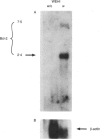Abstract
Expression of the c-kit proto-oncogene receptor on mast cells is essential for their normal proliferation and maturation as well as for several biological responses such as chemotaxis and attachment. In the present study we report that the interleukin-3 (IL-3)-dependent mast cell line CFTL-15 lacks the extracellular domain of the c-kit receptor. This observation was made after noting that the c-kit ligand stem cell factor (SCF) could not prevent IL-3 deprivation-induced mast cell apoptosis and that CFTL-15 cells did not proliferate in response to SCF. Flow cytometric analysis employing monoclonal anti-c-kit antibodies, and immunogold labelling with analysis by electron microscopy, subsequently showed a diminished expression of c-kit on CFTL-15 cells. There was no identifiable message for the extracellular domain of c-kit in these cells, as determined by reverse transcriptase-polymerase chain reaction (RT-PCR). These previously unrecognized properties of the CFTL-15 mast cell line allowed the examination of other biological consequences of the lack of c-kit on mast cells. Analysing the ability of these cells to adhere to surface-bound fibronectin, it was found that addition of SCF did not increase their adhesion to this substrate, in opposition to what is reported with other mast cells. Similarly, CFTL-15 mast cells did not adhere to fibroblasts, which is known to require c-kit expression. Also, there was no protein tyrosine phosphorylation in these cells in response to SCF. CFTL-15 cells underwent apoptosis on removal of IL-3 coincident with a decrease in endogenous Bcl-2 mRNA. Overexpression of Bcl-2 cDNA prolonged survival of Bcl-2-transfected CFTL-15 cells upon withdrawal of IL-3. Thus, the CFTL-15 cell line that lacks surface c-kit is not able to proliferate in response to SCF, undergoes apoptosis in the presence of SCF, and does not adhere to fibroblasts. These results confirm earlier studies on the functional consequences of c-kit and provide a novel experimental model for further investigation.
Full text
PDF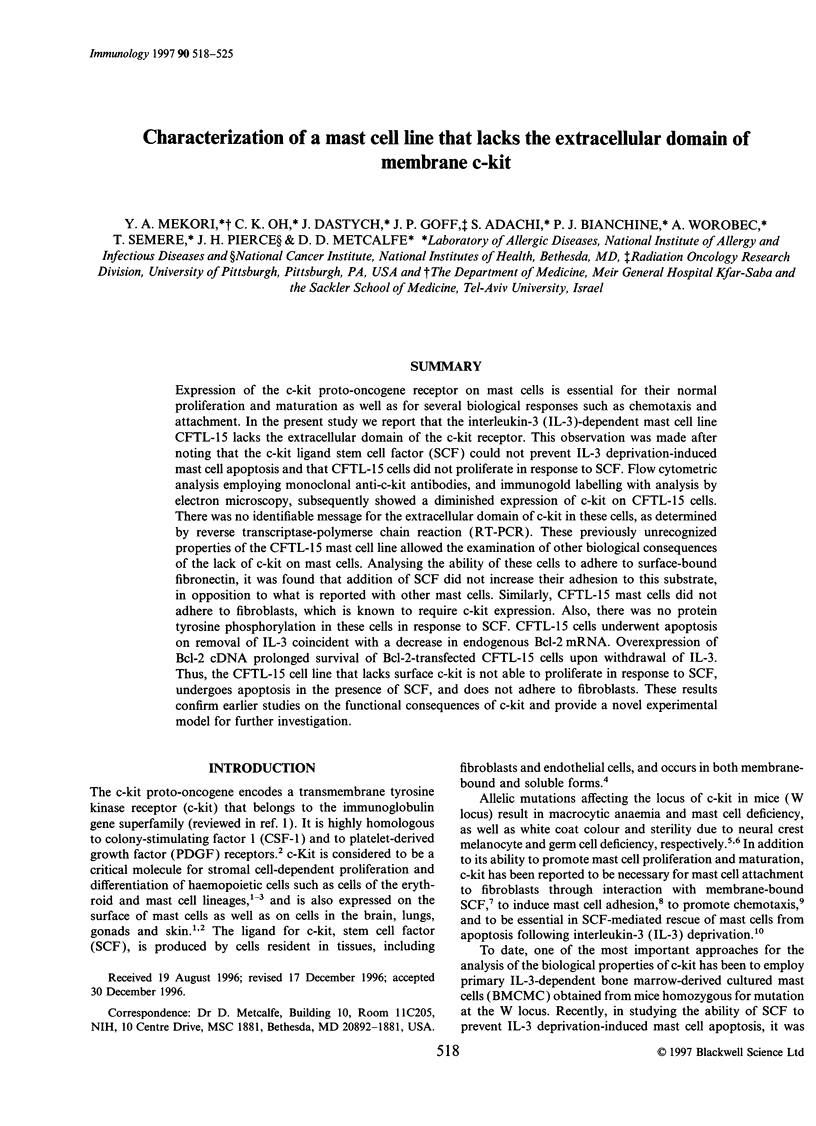
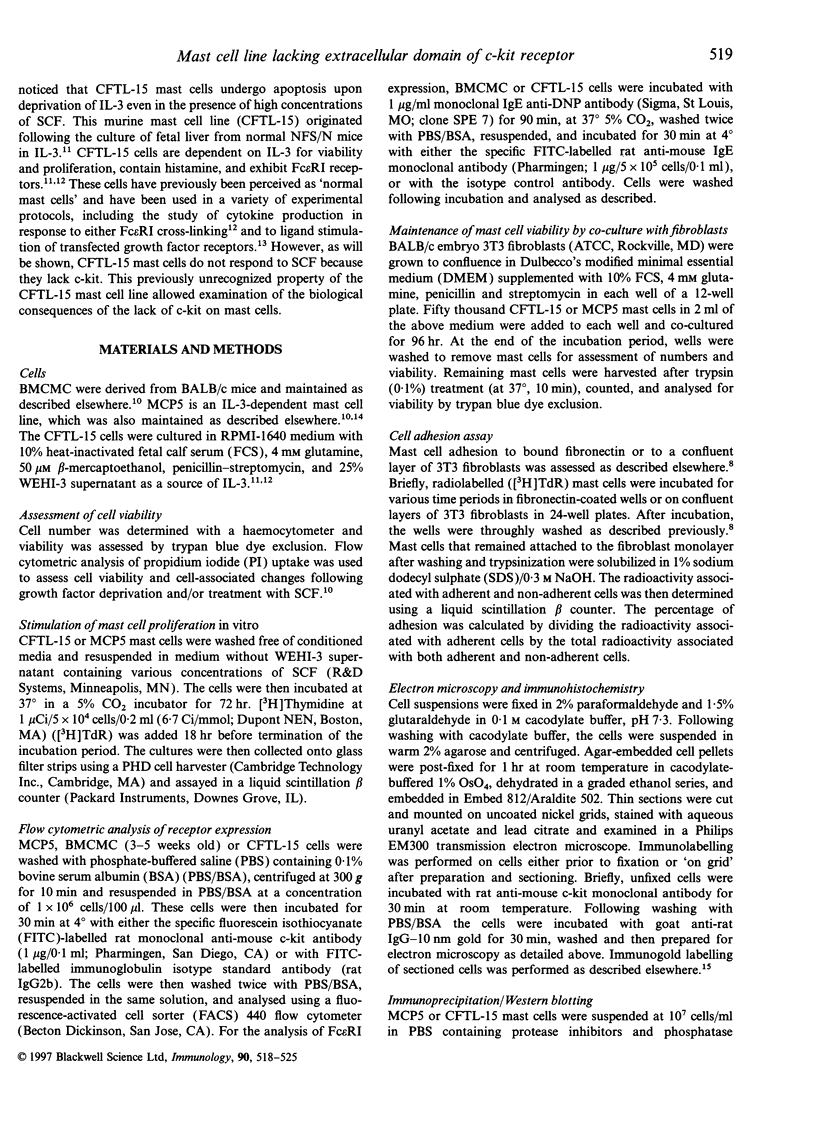

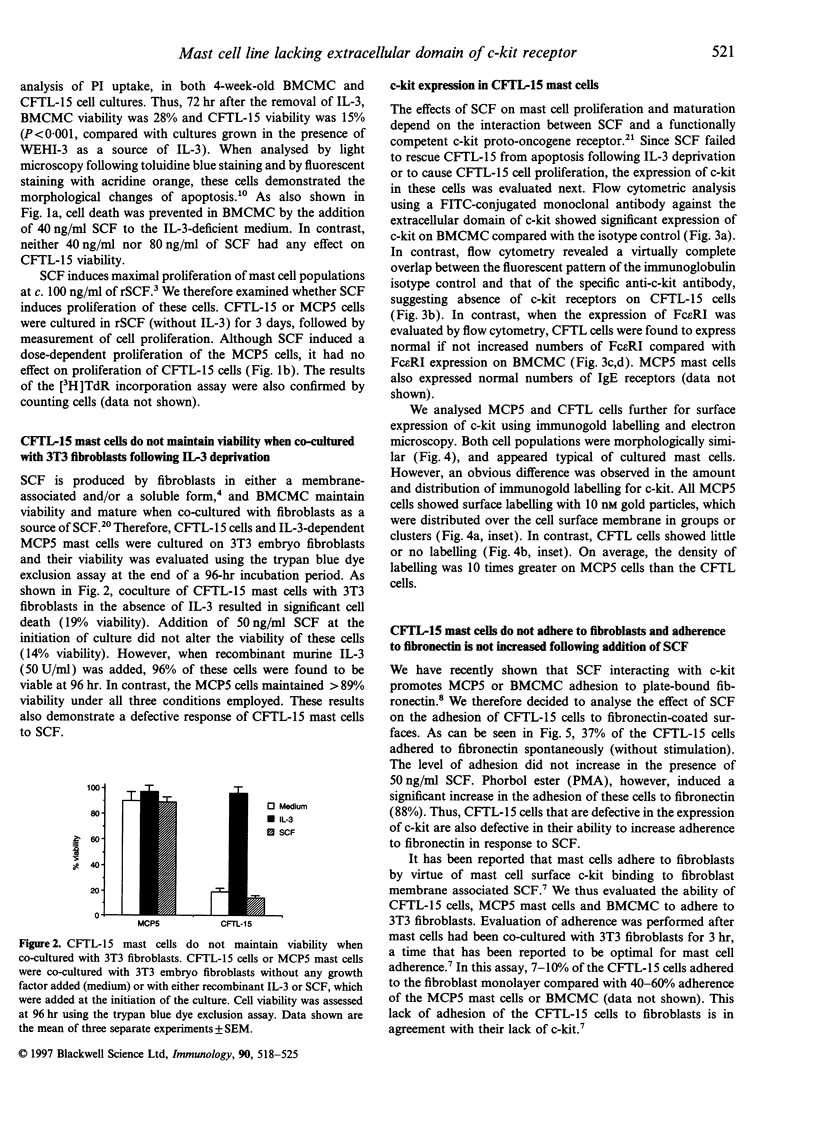
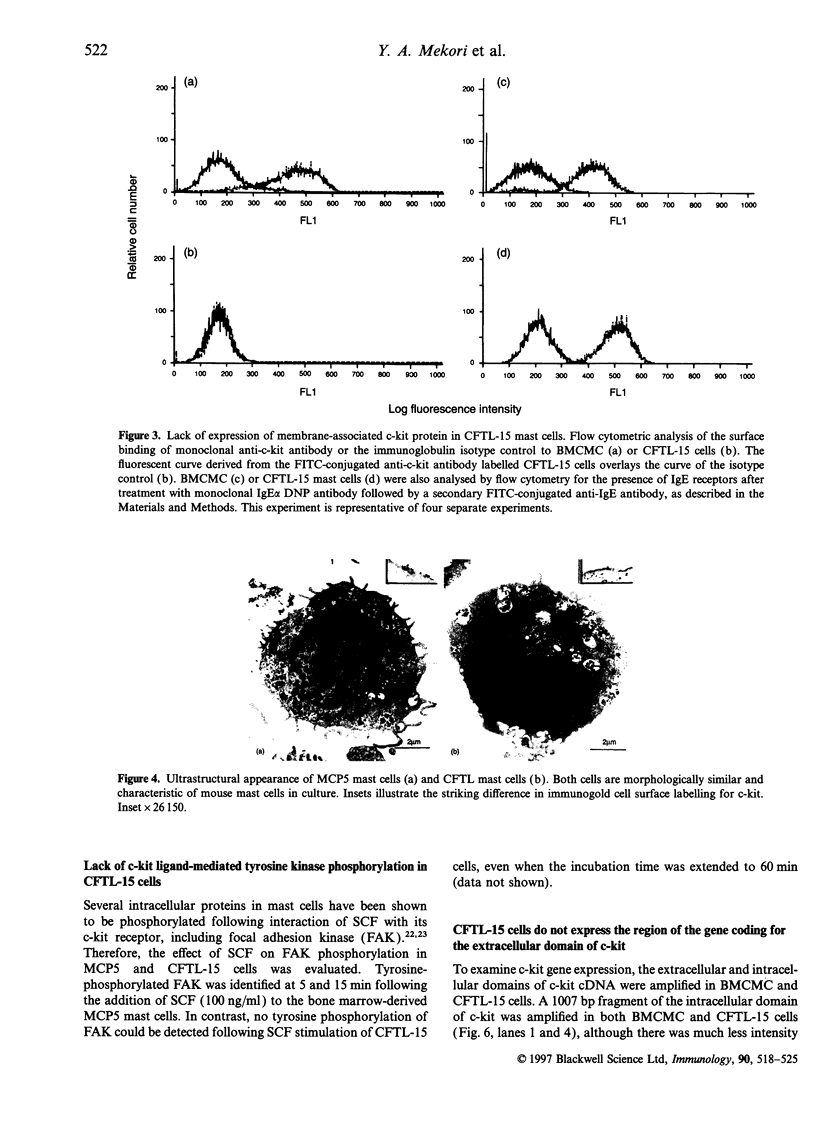

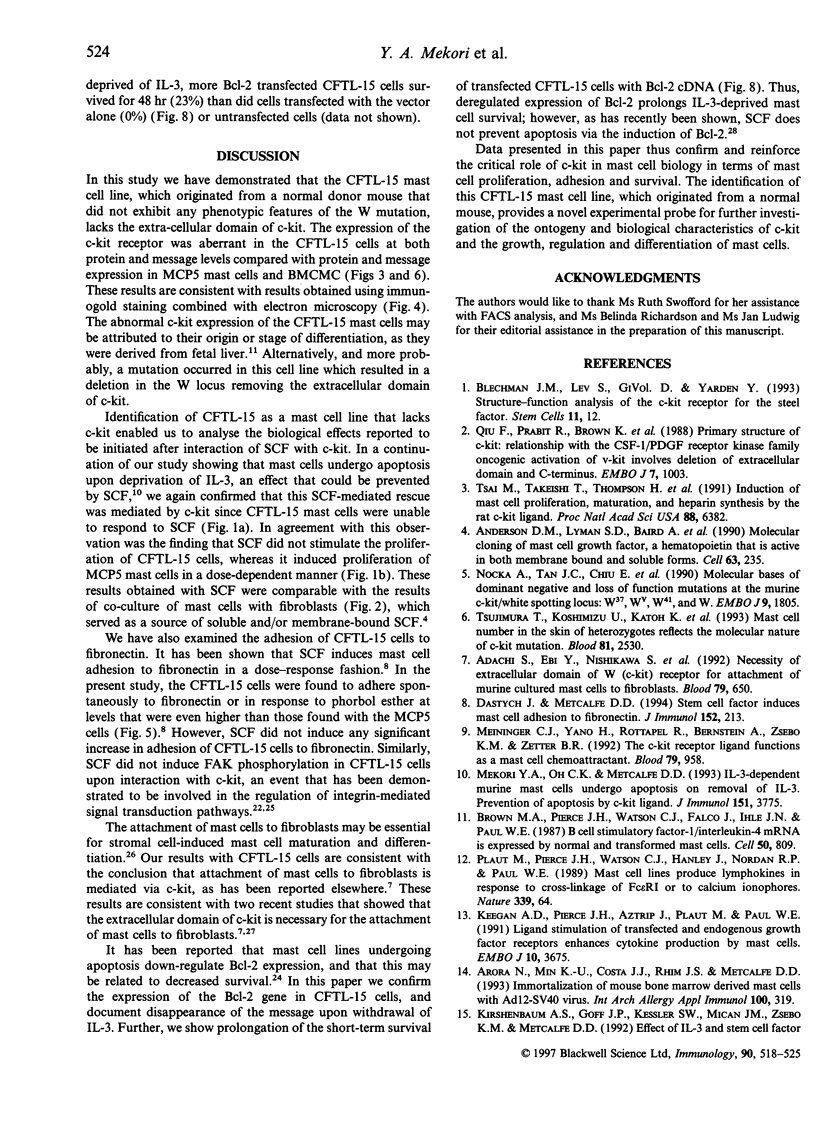
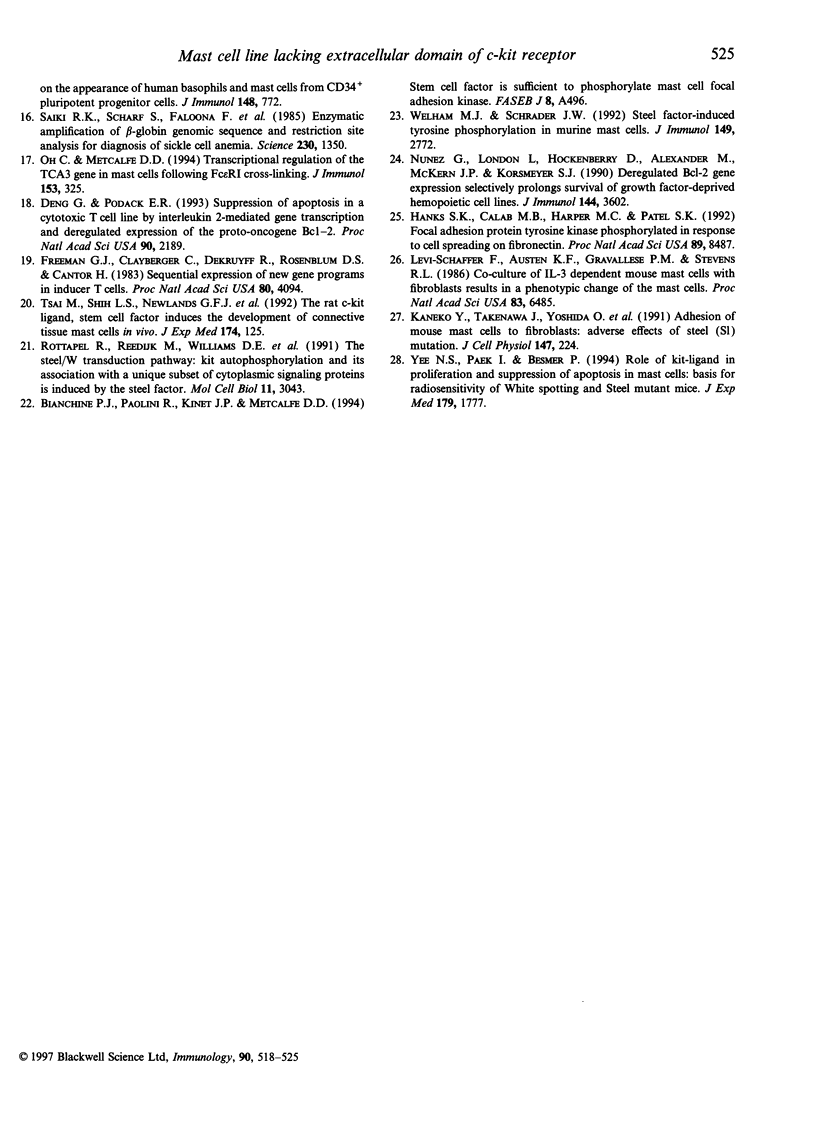
Images in this article
Selected References
These references are in PubMed. This may not be the complete list of references from this article.
- Adachi S., Ebi Y., Nishikawa S., Hayashi S., Yamazaki M., Kasugai T., Yamamura T., Nomura S., Kitamura Y. Necessity of extracellular domain of W (c-kit) receptors for attachment of murine cultured mast cells to fibroblasts. Blood. 1992 Feb 1;79(3):650–656. [PubMed] [Google Scholar]
- Anderson D. M., Lyman S. D., Baird A., Wignall J. M., Eisenman J., Rauch C., March C. J., Boswell H. S., Gimpel S. D., Cosman D. Molecular cloning of mast cell growth factor, a hematopoietin that is active in both membrane bound and soluble forms. Cell. 1990 Oct 5;63(1):235–243. doi: 10.1016/0092-8674(90)90304-w. [DOI] [PubMed] [Google Scholar]
- Arora N., Min K. U., Costa J. J., Rhim J. S., Metcalfe D. D. Immortalization of mouse bone marrow-derived mast cells with Ad12-SV40 virus. Int Arch Allergy Immunol. 1993;100(4):319–327. doi: 10.1159/000236432. [DOI] [PubMed] [Google Scholar]
- Brown M. A., Pierce J. H., Watson C. J., Falco J., Ihle J. N., Paul W. E. B cell stimulatory factor-1/interleukin-4 mRNA is expressed by normal and transformed mast cells. Cell. 1987 Aug 28;50(5):809–818. doi: 10.1016/0092-8674(87)90339-4. [DOI] [PubMed] [Google Scholar]
- Dastych J., Metcalfe D. D. Stem cell factor induces mast cell adhesion to fibronectin. J Immunol. 1994 Jan 1;152(1):213–219. [PubMed] [Google Scholar]
- Deng G., Podack E. R. Suppression of apoptosis in a cytotoxic T-cell line by interleukin 2-mediated gene transcription and deregulated expression of the protooncogene bcl-2. Proc Natl Acad Sci U S A. 1993 Mar 15;90(6):2189–2193. doi: 10.1073/pnas.90.6.2189. [DOI] [PMC free article] [PubMed] [Google Scholar]
- Freeman G. J., Clayberger C., DeKruyff R., Rosenblum D. S., Cantor H. Sequential expression of new gene programs in inducer T-cell clones. Proc Natl Acad Sci U S A. 1983 Jul;80(13):4094–4098. doi: 10.1073/pnas.80.13.4094. [DOI] [PMC free article] [PubMed] [Google Scholar]
- Hanks S. K., Calalb M. B., Harper M. C., Patel S. K. Focal adhesion protein-tyrosine kinase phosphorylated in response to cell attachment to fibronectin. Proc Natl Acad Sci U S A. 1992 Sep 15;89(18):8487–8491. doi: 10.1073/pnas.89.18.8487. [DOI] [PMC free article] [PubMed] [Google Scholar]
- Kaneko Y., Takenawa J., Yoshida O., Fujita K., Sugimoto K., Nakayama H., Fujita J. Adhesion of mouse mast cells to fibroblasts: adverse effects of steel (Sl) mutation. J Cell Physiol. 1991 May;147(2):224–230. doi: 10.1002/jcp.1041470206. [DOI] [PubMed] [Google Scholar]
- Keegan A. D., Pierce J. H., Artrip J., Plaut M., Paul W. E. Ligand stimulation of transfected and endogenous growth factor receptors enhances cytokine production by mast cells. EMBO J. 1991 Dec;10(12):3675–3682. doi: 10.1002/j.1460-2075.1991.tb04935.x. [DOI] [PMC free article] [PubMed] [Google Scholar]
- Levi-Schaffer F., Austen K. F., Gravallese P. M., Stevens R. L. Coculture of interleukin 3-dependent mouse mast cells with fibroblasts results in a phenotypic change of the mast cells. Proc Natl Acad Sci U S A. 1986 Sep;83(17):6485–6488. doi: 10.1073/pnas.83.17.6485. [DOI] [PMC free article] [PubMed] [Google Scholar]
- Meininger C. J., Yano H., Rottapel R., Bernstein A., Zsebo K. M., Zetter B. R. The c-kit receptor ligand functions as a mast cell chemoattractant. Blood. 1992 Feb 15;79(4):958–963. [PubMed] [Google Scholar]
- Mekori Y. A., Oh C. K., Metcalfe D. D. IL-3-dependent murine mast cells undergo apoptosis on removal of IL-3. Prevention of apoptosis by c-kit ligand. J Immunol. 1993 Oct 1;151(7):3775–3784. [PubMed] [Google Scholar]
- Nocka K., Tan J. C., Chiu E., Chu T. Y., Ray P., Traktman P., Besmer P. Molecular bases of dominant negative and loss of function mutations at the murine c-kit/white spotting locus: W37, Wv, W41 and W. EMBO J. 1990 Jun;9(6):1805–1813. doi: 10.1002/j.1460-2075.1990.tb08305.x. [DOI] [PMC free article] [PubMed] [Google Scholar]
- Nuñez G., London L., Hockenbery D., Alexander M., McKearn J. P., Korsmeyer S. J. Deregulated Bcl-2 gene expression selectively prolongs survival of growth factor-deprived hemopoietic cell lines. J Immunol. 1990 May 1;144(9):3602–3610. [PubMed] [Google Scholar]
- Oh C. K., Metcalfe D. D. Transcriptional regulation of the TCA3 gene in mast cells after Fc epsilon RI cross-linking. J Immunol. 1994 Jul 1;153(1):325–332. [PubMed] [Google Scholar]
- Plaut M., Pierce J. H., Watson C. J., Hanley-Hyde J., Nordan R. P., Paul W. E. Mast cell lines produce lymphokines in response to cross-linkage of Fc epsilon RI or to calcium ionophores. Nature. 1989 May 4;339(6219):64–67. doi: 10.1038/339064a0. [DOI] [PubMed] [Google Scholar]
- Qiu F. H., Ray P., Brown K., Barker P. E., Jhanwar S., Ruddle F. H., Besmer P. Primary structure of c-kit: relationship with the CSF-1/PDGF receptor kinase family--oncogenic activation of v-kit involves deletion of extracellular domain and C terminus. EMBO J. 1988 Apr;7(4):1003–1011. doi: 10.1002/j.1460-2075.1988.tb02907.x. [DOI] [PMC free article] [PubMed] [Google Scholar]
- Rottapel R., Reedijk M., Williams D. E., Lyman S. D., Anderson D. M., Pawson T., Bernstein A. The Steel/W transduction pathway: kit autophosphorylation and its association with a unique subset of cytoplasmic signaling proteins is induced by the Steel factor. Mol Cell Biol. 1991 Jun;11(6):3043–3051. doi: 10.1128/mcb.11.6.3043. [DOI] [PMC free article] [PubMed] [Google Scholar]
- Saiki R. K., Scharf S., Faloona F., Mullis K. B., Horn G. T., Erlich H. A., Arnheim N. Enzymatic amplification of beta-globin genomic sequences and restriction site analysis for diagnosis of sickle cell anemia. Science. 1985 Dec 20;230(4732):1350–1354. doi: 10.1126/science.2999980. [DOI] [PubMed] [Google Scholar]
- Tsai M., Shih L. S., Newlands G. F., Takeishi T., Langley K. E., Zsebo K. M., Miller H. R., Geissler E. N., Galli S. J. The rat c-kit ligand, stem cell factor, induces the development of connective tissue-type and mucosal mast cells in vivo. Analysis by anatomical distribution, histochemistry, and protease phenotype. J Exp Med. 1991 Jul 1;174(1):125–131. doi: 10.1084/jem.174.1.125. [DOI] [PMC free article] [PubMed] [Google Scholar]
- Tsai M., Takeishi T., Thompson H., Langley K. E., Zsebo K. M., Metcalfe D. D., Geissler E. N., Galli S. J. Induction of mast cell proliferation, maturation, and heparin synthesis by the rat c-kit ligand, stem cell factor. Proc Natl Acad Sci U S A. 1991 Jul 15;88(14):6382–6386. doi: 10.1073/pnas.88.14.6382. [DOI] [PMC free article] [PubMed] [Google Scholar]
- Tsujimura T., Koshimizu U., Katoh H., Isozaki K., Kanakura Y., Tono T., Adachi S., Kasugai T., Tei H., Nishimune Y. Mast cell number in the skin of heterozygotes reflects the molecular nature of c-kit mutation. Blood. 1993 May 15;81(10):2530–2538. [PubMed] [Google Scholar]
- Welham M. J., Schrader J. W. Steel factor-induced tyrosine phosphorylation in murine mast cells. Common elements with IL-3-induced signal transduction pathways. J Immunol. 1992 Oct 15;149(8):2772–2783. [PubMed] [Google Scholar]
- Yee N. S., Paek I., Besmer P. Role of kit-ligand in proliferation and suppression of apoptosis in mast cells: basis for radiosensitivity of white spotting and steel mutant mice. J Exp Med. 1994 Jun 1;179(6):1777–1787. doi: 10.1084/jem.179.6.1777. [DOI] [PMC free article] [PubMed] [Google Scholar]





